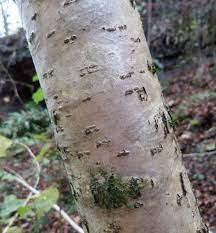
What are lenticels in biology?


Answer
390.9k+ views
Hint: On stems and roots, lenticels appear as elevated circular, oval, or elongated patches. Lenticels are rough, cork-like structures that grow on juvenile branches of woody plants. Porous tissue creates a lot of huge intercellular gaps between cells beneath them.
Complete answer:
A lenticel is a porous tissue found in the periderm of secondary thickening organs, as well as the bark of woody stems and roots of dicotyledonous flowering plants, that consists of cells with vast intercellular spaces.
It acts as a pore, allowing direct gas exchange between internal tissues and the atmosphere via the bark, which would otherwise be impervious to gases. A tiny pore near a plant's stomata that permits gaseous exchange between the plant's internal and exterior surroundings.
Its lenticular (lens-like) shape inspired the word lenticel, which is pronounced with a [s]. One of the traits used to identify trees is the shape of their lenticels.
Lenticels promote gas exchange of oxygen, carbon dioxide, and water vapour in plant bodies that induce secondary growth. Lenticel production occurs beneath stomatal complexes during early growth, just before the first periderm develops.
This tissue emerges from cell division in the phellogen or substomatal ground tissue and fills the lenticel. Lenticular discoloration can also occur, such as in mangoes, due to the quantity of lignin in the cell walls.
Note: The production of lenticels appears to be linked to the growth and strength of the shoot, as well as the tissue's hydrose, or internal moisture. Lenticel formation continues in the new periderm as stems and roots mature.
Complete answer:
A lenticel is a porous tissue found in the periderm of secondary thickening organs, as well as the bark of woody stems and roots of dicotyledonous flowering plants, that consists of cells with vast intercellular spaces.
It acts as a pore, allowing direct gas exchange between internal tissues and the atmosphere via the bark, which would otherwise be impervious to gases. A tiny pore near a plant's stomata that permits gaseous exchange between the plant's internal and exterior surroundings.
Its lenticular (lens-like) shape inspired the word lenticel, which is pronounced with a [s]. One of the traits used to identify trees is the shape of their lenticels.
Lenticels promote gas exchange of oxygen, carbon dioxide, and water vapour in plant bodies that induce secondary growth. Lenticel production occurs beneath stomatal complexes during early growth, just before the first periderm develops.
This tissue emerges from cell division in the phellogen or substomatal ground tissue and fills the lenticel. Lenticular discoloration can also occur, such as in mangoes, due to the quantity of lignin in the cell walls.
Note: The production of lenticels appears to be linked to the growth and strength of the shoot, as well as the tissue's hydrose, or internal moisture. Lenticel formation continues in the new periderm as stems and roots mature.
Recently Updated Pages
Master Class 11 English: Engaging Questions & Answers for Success

Master Class 11 Computer Science: Engaging Questions & Answers for Success

Master Class 11 Maths: Engaging Questions & Answers for Success

Master Class 11 Social Science: Engaging Questions & Answers for Success

Master Class 11 Economics: Engaging Questions & Answers for Success

Master Class 11 Business Studies: Engaging Questions & Answers for Success

Trending doubts
10 examples of friction in our daily life

What problem did Carter face when he reached the mummy class 11 english CBSE

One Metric ton is equal to kg A 10000 B 1000 C 100 class 11 physics CBSE

Difference Between Prokaryotic Cells and Eukaryotic Cells

State and prove Bernoullis theorem class 11 physics CBSE

The sequence of spore production in Puccinia wheat class 11 biology CBSE




